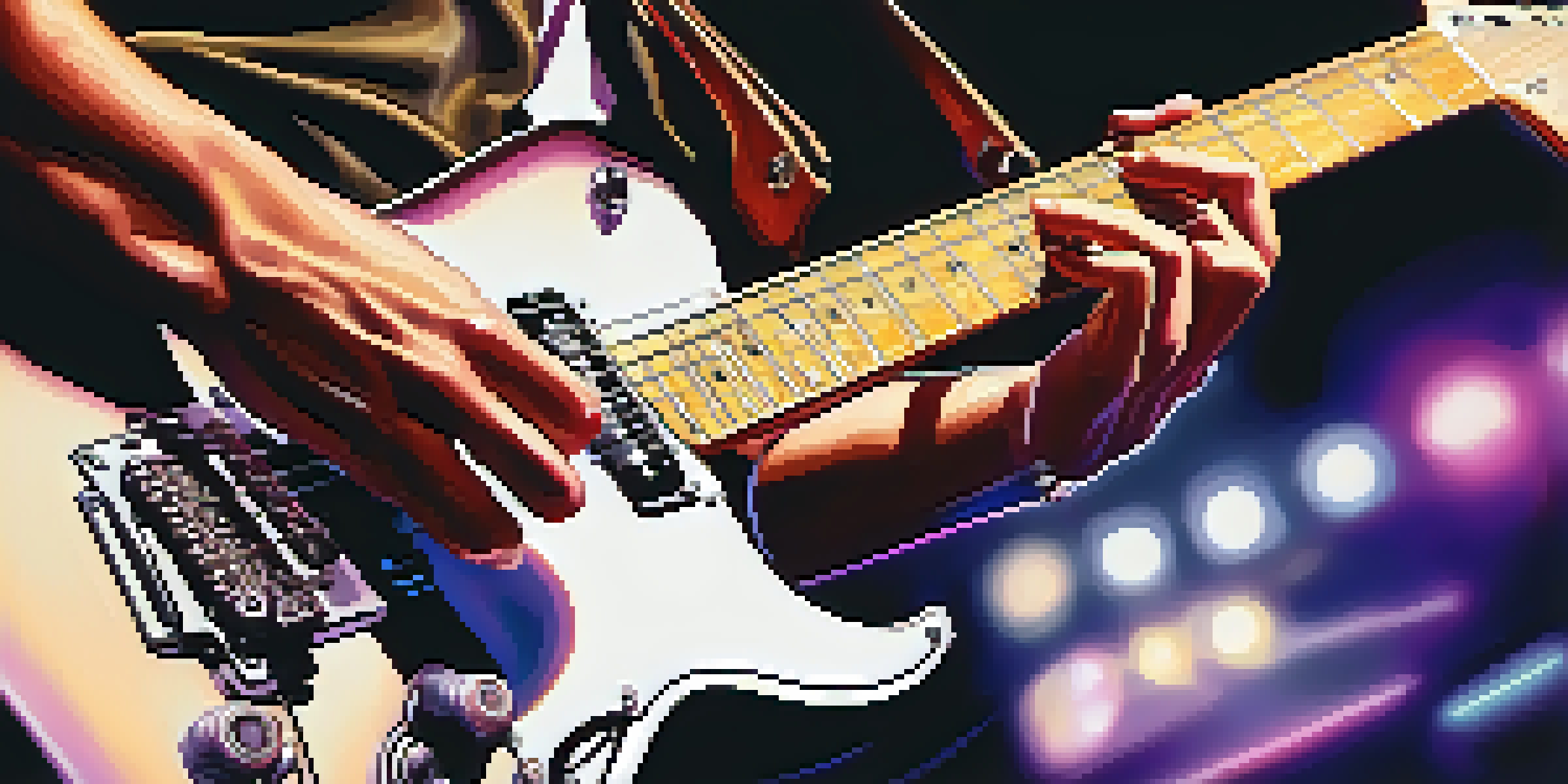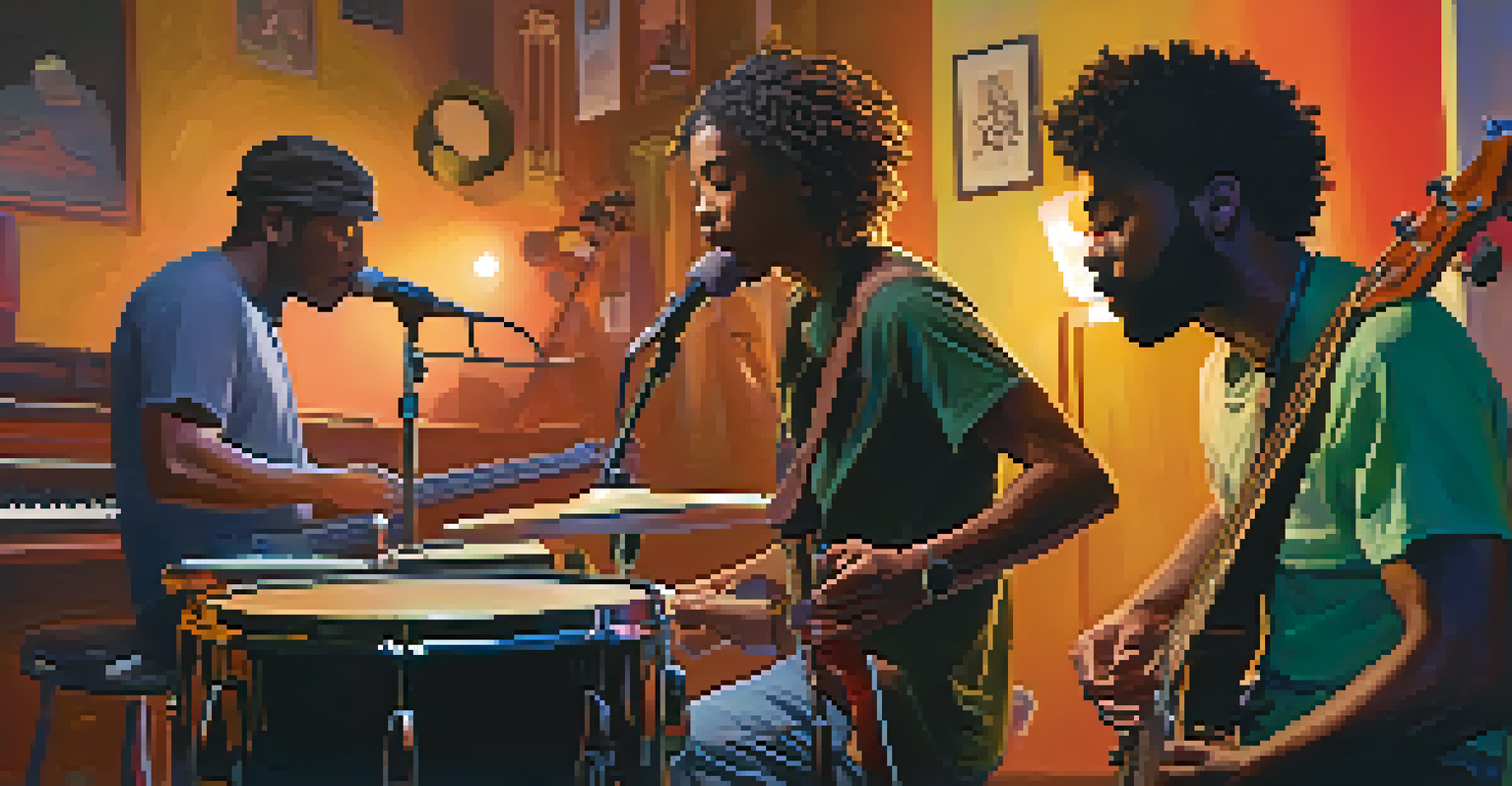The Role of Improvisation in Emotional Guitar Playing

Understanding Improvisation in Guitar Music
Improvisation in guitar playing is the art of creating music spontaneously. It allows musicians to express their emotions in real-time, often leading to unique and heartfelt performances. Think of it as a conversation between the guitarist and their instrument, where every note reflects their current feelings and thoughts.
Improvisation is the ability to create something out of nothing.
Many great guitarists, like Jimi Hendrix and Eric Clapton, are known for their improvisational skills. They could take a simple chord progression and turn it into an emotional journey through their spontaneous playing. This ability to improvise can transform a standard piece into something deeply personal and moving.
In essence, improvisation is not just about technical skill; it's about connecting with the music and the audience on a deeper level. It invites both the player and the listener into an intimate experience, making each performance truly one-of-a-kind.
The Emotional Connection in Music Improvisation
Improvisation serves as a bridge between a guitarist’s emotions and their audience. When a guitarist improvises, they are often tapping into their feelings, whether joy, sadness, or nostalgia, which can resonate with listeners. This emotional connection can turn a simple melody into something that evokes strong memories or feelings.

For example, a guitarist might play a soulful blues riff that captures the essence of heartbreak. The spontaneity of improvisation allows them to express raw emotions that might otherwise remain unarticulated. This is why many musicians believe that improvisational moments often yield the most powerful musical expressions.
Improvisation Enhances Emotional Depth
Improvisation allows guitarists to express their emotions spontaneously, creating unique and moving performances.
Ultimately, the emotional connection fostered through improvisation can leave a lasting impression on listeners. It creates a shared experience where the audience feels the music as much as the artist does, making every performance unique and memorable.
Techniques for Emotional Improvisation
To effectively improvise emotionally on the guitar, musicians often rely on specific techniques. These can include bending notes, using vibrato, and varying dynamics to convey different feelings. For instance, a slow, sustained note with vibrato might evoke deep sorrow, while quick, staccato notes could express excitement.
The music is not in the notes, but in the silence between.
Another key technique is the use of scales and modes that align with the desired emotion. For example, the Dorian mode is often used to create a jazzy, yet melancholic feel, while the Mixolydian mode can bring a sense of celebration. By mastering these scales, guitarists can unlock a wider emotional palette.
Additionally, listening to other musicians and studying their improvisational styles can be invaluable. By analyzing how different artists convey emotion through their playing, guitarists can incorporate new ideas into their own improvisational toolkit.
The Role of Listening in Improvisational Skills
Listening is just as crucial as playing when it comes to improvisation. A successful improviser pays attention not only to their own playing but also to the other musicians in the ensemble. This attentiveness allows for a cohesive performance where everyone contributes to the emotional landscape of the music.
For example, in a jam session, a guitarist might pick up on a drummer's rhythm shift, adjusting their playing to enhance the overall groove. This kind of interaction creates a dynamic atmosphere, where the music evolves organically. It’s a dance of sound that relies heavily on communication and awareness.
Listening Fuels Improvisational Skills
Active listening to other musicians enhances a guitarist's ability to improvise, fostering a cohesive and dynamic performance.
Moreover, active listening can inspire new ideas and directions for improvisation. By absorbing different musical styles and nuances from other players, guitarists can enrich their own emotional expression and develop a more versatile approach to their craft.
Overcoming Fear in Improvisation
Fear often holds musicians back from fully embracing improvisation. The anxiety of making mistakes or not being 'good enough' can stifle creativity and emotional expression. However, recognizing that imperfections are part of the journey can help musicians feel more liberated in their playing.
One effective way to combat this fear is through practice and familiarity with the instrument. The more comfortable a guitarist is with their guitar and techniques, the more confident they'll feel in improvisational settings. Regular practice can build a strong foundation, allowing for freedom and exploration during performances.
Additionally, participating in group jams or improvisation workshops can provide a supportive environment to practice. Surrounding oneself with fellow musicians can encourage experimentation and foster a sense of community, making it easier to overcome the fear of improvisation.
Finding Your Unique Voice Through Improvisation
Every guitarist has a distinct voice, and improvisation is a powerful tool for discovering it. By experimenting with different styles, techniques, and emotional expressions, musicians can carve out their own sound. This journey of self-discovery is not just about technical ability but also about finding what resonates with them personally.
For instance, a guitarist may start by imitating their favorite artists, gradually developing their own style as they gain confidence. This exploration can lead to unexpected discoveries and a deeper understanding of their musical identity. Over time, these improvisational moments can reveal a unique voice that stands out in a crowded musical landscape.
Overcoming Fear Boosts Creativity
Confronting the fear of mistakes through practice and supportive environments encourages greater freedom in improvisation.
Ultimately, embracing improvisation allows guitarists to communicate their individuality through music. It’s about expressing who they are and what they feel in the moment, creating a signature sound that is uniquely theirs.
The Impact of Improvisation on Live Performances
Improvisation can significantly enhance live performances, making them more engaging and unpredictable. Audiences are often drawn to the excitement of spontaneous playing, as it creates a sense of shared experience. When a guitarist takes the stage and improvises, they invite listeners into a journey where anything can happen.
For example, a well-placed improvisational solo can elevate a song, adding depth and emotional intensity that wasn’t present in the studio version. This connection can turn an ordinary concert into a memorable event, leaving the audience buzzing long after the final note is played.

Moreover, the element of surprise in improvisation fosters a unique bond between the performer and the audience. It encourages a sense of excitement and anticipation, highlighting the unpredictable nature of live music and making each performance a distinct experience.